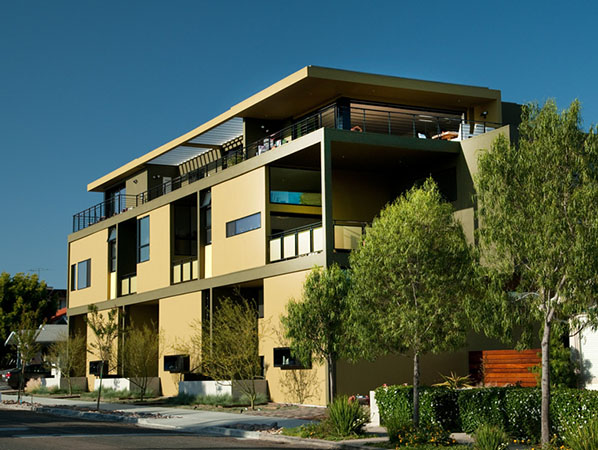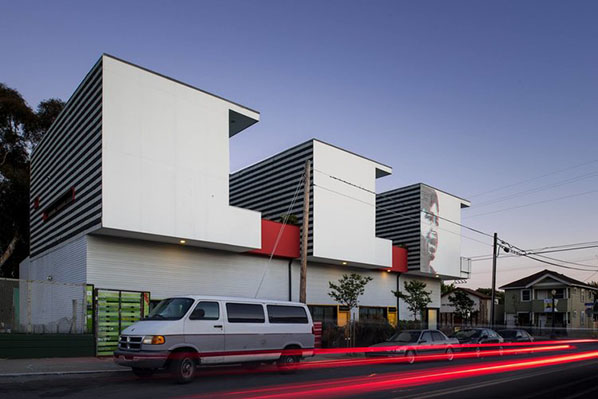
[Originally published 2nd quarter 2011, in arcCA 11.2, “The Business of Architecture.”]
arcCA asked three architect-developers in San Diego, where the species seems to flourish, to tell us about their motivations and experiences. Lloyd Russell, AIA, has been a practicing architect since 1997. He was AIA San Diego’s Young Architect of the Year and was a featured speaker in the Emerging Talent Series at the Monterey Design Conference in 2007. Jonathan Segal, FAIA, is principal of Jonathan Segal Architects, which provides real estate development, architecture, construction, ownership, and property management all in house. The firm initiates urban renewal in the most blighted areas of Downtown San Diego, for other new development to follow; and promotes this form of practice to other architects so they also can have control, pride in their work, and financial independence. Ted Smith is a principal of Smith and Others, an alternative architectural practice founded in 1973; Kathleen McCormick joined the practice in 1981. Smith chairs the Masters in Real Estate program for architects at Woodbury University. Here, Russell and Segal join in a dialogue; Ted Smith’s narrative follows.
What prompted you to undertake your first development project?
Lloyd Russell: There was no work happening at the time, so we used to joke that the only way to get hired was to hire ourselves. At a time when architects are getting marginalized in the building industry, it is empowering to be in the middle of things bringing a project to realization. And, if you do it well, you get to own it. It’s also putting your money where your mouth is. Architects promote the profession with the argument that we add value. Well, why not realize that value?
Jonathan Segal: I never wanted to have a client after working at two firms and seeing the lack of respect the clients give to the architects and the compromises they were forced to make. Just as significant was the pittance they were paid in comparison to the contractor.
Did you have training or experience that specifically prepared you to do development?
LR: I used to believe what my teachers at San Luis Obispo were telling me, namely that architecture would save the world. Problem was, I had to drive thru LA to get to school from San Diego, and I could not rationalize what I was seeing from the freeway through that paradigm. So I got interested not just in how buildings were built but why. And who made those decisions.
JS: I’m Jewish. But all architects have the tools required to do development.

Are you also the general contractor for your projects?
LR: Owner-builder, technically.
JS: Not in the beginning, but after building a few projects and seeing the generals take no responsibility for the work I paid them to do, I finally woke up and vowed never to hire another contractor again. They add no value and only subtract from the process, and now we always build our own work and have never looked back.
Did you have training or experience that prepared you to act as G.C.?
LR: I worked construction trades through school and after graduation without telling anyone I was a graduate. I got an earful on what contractors think about architects.
JS: Yes: the same experience that all architects have. Contractors don’t have any better skills than we do, and they have zero passion in our process. Passion is at the heart of every project.
What is your approach to risk management?
LR: I prefer to develop multifamily for rent instead of for sale. Ironically, when you take on all the responsibilities/liabilities of multiple roles, you get to a tipping point where the risk becomes less, because you won’t sue yourself.
JS: Build your own stuff; get the subcontractors to indemnify you, not the other way around; build apartments, never condos.

What do you most enjoy about your mode of practice?
LR: It’s more a lifestyle than a practice. You make different decisions on when, where, and why to take on a project when you have a stable
cash flow from prior projects.
JS: Multi-tasking and seeing our sculptures take shape. Most importantly, we have a sustainable practice that has rental income and creates long term balance sheet growth. It’s time to help all other architects do what we do.
Ted Smith: I first developed a house for my family. I’m not sure you call that development, but I guess it is. That was in 1975. Five years later, the economy was crashing, no one was hiring architects, and I couldn’t make my mortgage payment, so I borrowed one last $20,000 from a hard money lender and builtmy first real development, where I was counting on renting space to pay the bills. That was the first of a series of shared houses with six suites in each, with private exterior entrances, that I called GoHomes. These turned out to be popular, and I built five such houses over as many years, each with six to eight suites, providing very affordable ownership in pricy Del Mar Terrace.
Over this same period, the demographic of the neighborhood changed from surfers and academics at UCSD to yuppies, with property values as their main interest. The new people didn’t like affordable housing, so I left the Terrace and joined my good friend Rob Quigley downtown, where he and Kathleen Hallahan had built their new home and office in Little Italy. Kathy McCormick, my collaborator and by the way girlfriend, was looking at the Sunday paper, and she saw a lot that cost about the same as the lots in Del Mar Terrace, but you could build a big building there, and there were no Nimbys. So we moved our practice downtown and built San Diego’s first (as far as we knew) townhouses, something Kathy was championing, along with a bunch of GoHomes. We called the building the Richman/Poorman building, since it combined high-end row houses with tiny apartments in one building.
We found these experiences extremely rewarding, being able to invent the building type, which seemed much more substantial than decorating some developer’s bad idea. We could serve a population that we understood and direct the development to places that were more friendly to the environment than, say, the big custom homes we had been designing in Fairbanks Ranch. This ability to control the project remains the overriding motivation behind deciding to be an architect/developer. Of course, we also had learned that it was easier to borrow money from banks than to collect it from clients, and the income from apartments was recession proof, freeing up the anxiety that comes with the cyclical traditional practice of architecture.
I was untrained when I began, and that naiveté is probably the only reason I would have tried development. Certainly, a project like the GoHomes would not have come from someone with wisdom. If I had understood the complexities, I probably would have shied away.
I’ve always built the projects I have developed. I had built my first house, and I always understood that the construction is where the money is. I also learned that it was less trouble to be the contractor than argue with one. I learned to build on the job, and any mistakes I made were well worth the substantial savings.
My staff has always been young architects, whom I would partner with to accomplish the projects. This is expensive, because you end up giving away a lot more than you might if you had the money to hire, but a group is more powerful than an individual, and I have always been a bit of a socialist when it comes to being fair and providing opportunities. When one develops, profits are way down the road, so it is good to have all the staff on board, agreeing to show up and work for some common goal way off in the future, and a group helps establish a discipline that working alone does not. Everyone agrees to show up first thing in the morning and work until dark. Also, many jobs just require a number of people to accomplish, like framing or building a foundation or placing the windows. We always do about half the subcontracts, as well as act as the GC. I have had many young, talented architects help make the projects, and they have nearly all been partners. Only on very large projects have they been joined by paid staff.
As soon as projects become larger than, say, four units, a rich man is required to cosign the loans. So these projects are not for beginners without wealth. Small projects are also the projects that need to get built, infill. Normal developers don’t want to build small, because the effort is the same no matter the scale. I prefer a street of individual ownerships, an expression of community, over a full-block building that seems more to express a developer’s big money dreams. The big (and mostly bad) projects get built anyway. It’s the fine-grained projects that require a very large amount of work for their size. The purpose of the Master in Real Estate Development program at Woodbury University is to teach these skills to young architects, who are the ones schooled enough in what is good urbanism to take these infill projects on. The big guys can go ahead building the full blocks, tracts, and industrial parks.
I manage my risks by doing as much as I can by myself and by careful choice of partners. That way, when something goes wrong, it is our fault. I can get a screwdriver and fix it, rather than hire a lawyer. I also build for a market of young, artistic people, the kind who see the world in a good way. I am less comfortable building for people with money. If they have money, they are probably not my market; and, besides, they are probably the kind of people who will sue me, rather than be reasonable. This has worked well for me. I haven’t been sued as a developer, except once almost by a disgruntled partner. I figured out how to buy the unhappy partner out, and it all was OK. That is one instance in what has been thirty years of development at this point. So, risk management has more to do with picking partners than buying insurance.
I enjoy development, because it builds wealth, and it builds those projects that would not be built by the normal industry. I love being in control, and I am always advising young architects to stop traditional practice as soon as possible. It seems to me that the normal practice of architecture is a foolish endeavor, where wonder is promised in school only to run up against the sad reality that is normal practice or services for hire. Traditional practitioners, except in extremely rare cases, make way less money and have way less control, so the architecture is worse and the income intermittent. Of course, there are exceptions to anything one says. Certainly there are many good architects, who, with savvy political skills, navigate the treachery of traditional practice and even make great buildings, but I’ve never been too good at trying to sell an idea; I’d rather just decide to do it. It’s enough trouble just to sell an idea to myself.





